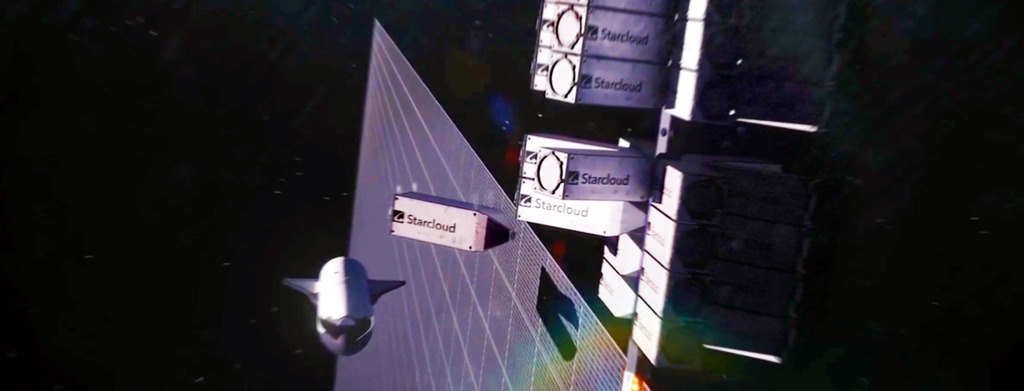The Sky: The New Server Room — Starcloud’s $10 Million Investment 🌌
🚀The Dawn of a New Era: Orbital Computing
In this detailed and narrative report, we’ll look at Starcloud — the startup aiming to move data centers from Earth to orbit — through technical, economic, environmental, and strategic lenses.
In early 2025, a small yet symbolic satellite — called Starcloud-1 — was launched into low Earth orbit, carrying one of the most powerful AI processors of today: the NVIDIA H100. From an engineering standpoint, it was a technological showcase; from a symbolic one, it marked the beginning of a new chapter in computing infrastructure.
🌍From Earth to Orbit: Context and Necessity
For decades, terrestrial data centers have been the vital arteries of the digital economy — but they come with hidden costs: high energy consumption, massive cooling requirements, water usage, and continuous electricity demand. Today, data centers account for about 2–3% of global electricity consumption — a number that continues to rise with the growth of AI and IoT.
Meanwhile, we’re witnessing an explosion of space-borne data: satellites, Earth-observation sensors, and communication systems produce petabytes of information daily. Much of it requires rapid processing — from wildfire detection to climate analytics and maritime tracking. Sending all that raw data back to Earth is bandwidth-inefficient and costly.
Energy Consumption
Terrestrial data centers consume 2–3% of global electricity. As AI and IoT grow, this figure is rapidly increasing. These centers also require millions of liters of water yearly for cooling, putting additional stress on freshwater resources.
Data Explosion in Space
Satellites generate petabytes of data every day, requiring immediate analysis — from precision agriculture to climate monitoring. Rapid processing is essential for real-time decision-making.
Bandwidth Limits
Transmitting huge volumes of data to Earth isn’t cost-effective. By processing data in orbit, only analyzed results are sent back, saving up to 90% in bandwidth usage.
“What we call ‘the cloud’ today needs a new geography — and that geography might just be above our heads.”
— Jensen Huang, CEO of NVIDIA
💻Starcloud-1: The First Orbital Computing Node
Starcloud-1 is a 60-kilogram microsatellite built on the Corvus-Micro platform, carrying an NVIDIA H100 GPU. Its primary mission: to test live AI workloads in orbit, study hardware durability under cosmic radiation, and prove the feasibility of edge processing in space.
| Component | Details |
|---|---|
| Satellite Name | Starcloud-1 |
| Mass | ≈ 60 kg |
| Processor | NVIDIA H100 GPU |
| Platform | Corvus-Micro (Astro Digital) |
| Objective | In-orbit inference / edge computing validation |
📈Market Drivers: Why Now?
Several converging trends make this the right moment:
- AI Explosion 🤖: Large models demand vast computational power. With the exponential growth of LLMs, compute requirements are soaring.
- Satellite Proliferation 🛰️: Thousands of new satellites for imaging, communication, and sensing are being launched by companies like SpaceX, Amazon, and OneWeb.
- Falling Launch Costs 🚀: Reusable rockets from SpaceX and others have cut launch costs by up to 10×, making space services economically viable.
- Solar Power Potential ☀️: Above the atmosphere, sunlight is continuous — allowing 8–10× more energy generation compared to Earth-based solar panels.
✨Benefits and Applications
If this model proves scalable, the benefits could be transformative:
Cost Reduction
Sending only processed results to Earth — not raw data — could cut data-transfer costs by up to 90%, saving millions annually.
Lower Latency
Processing data near its source enables faster decisions — critical in disaster monitoring, where milliseconds can save lives.
Energy Sustainability
Solar-powered orbital nodes require no water-based cooling. Such systems could reduce carbon footprints by up to 80% compared to ground data centers.
| Sector | Practical Example |
|---|---|
| Precision Agriculture 🌾 | Real-time satellite image analysis to detect droughts, pests, or optimize irrigation |
| Disaster Management 🚨 | Automatic detection of wildfires and floods with real-time alerts to authorities |
| Maritime ⚓ | Ship tracking for safety and cargo monitoring with high accuracy |
| Climate & Meteorology 🌦️ | Large-scale climate modeling using in-orbit processed datasets |
⚠️Technical Challenges and Risks
Every breakthrough comes with risks. For Starcloud, key challenges include:
- Radiation ☢️: High-energy particles can damage memory and transistors, causing computation errors and hardware degradation.
- Thermal Management 🔥: Without air, heat transfer only occurs via radiation — requiring precise thermal panel design. H100 GPUs generate significant heat.
- Maintenance 🔧: Physical repair in orbit is complex and costly, so systems must be fault-tolerant and self-healing. Redundancy is vital.
- Orbital Debris 🗑️: Increasing orbital congestion raises collision risks. Debris management is now a major concern for all space activities.
“When a server fails in orbit, there’s no ‘Restart’ button. Designing for self-healing and redundancy is essential.”
— Dr. Susan Fitzpatrick, NASA Researcher
💬Expert Insights
“When launch costs dropped below a few thousand dollars per kilogram, new space architectures finally became economical.”
— Elon Musk, Founder of SpaceX
“We’ve always said the future is in space — and now, data seems to be getting there before humans do.”
— Jeff Bezos, Founder of Amazon & Blue Origin
“Performing high-performance computing in orbit could become one of the most significant infrastructure innovations of this century.”
— John Dinsdale, Chief Analyst, Synergy Research Group
🔭Outlook: The Convergence of Earth and Orbit
Starcloud envisions a network of interconnected orbital nodes — linked via ultra-fast laser channels, communicating with Earth and each other. In such a constellation, satellites could not only collect data but also analyze, decide, and respond autonomously.
In the longer term, this orbital compute network could even serve lunar or Martian bases — gradually extending infrastructure beyond low Earth orbit. Such an ecosystem could accelerate humanity’s path toward space habitation.
📚Sources & Further Reading
• Starcloud funding report on GeekWire: GeekWire
• DataCenterDynamics coverage on Starcloud-1 launch with NVIDIA H100: DataCenterDynamics
• NVIDIA official site (general H100 info): NVIDIA
• Official pages of SpaceX, Blue Origin, and Rocket Lab for public statements and technical analyses.

